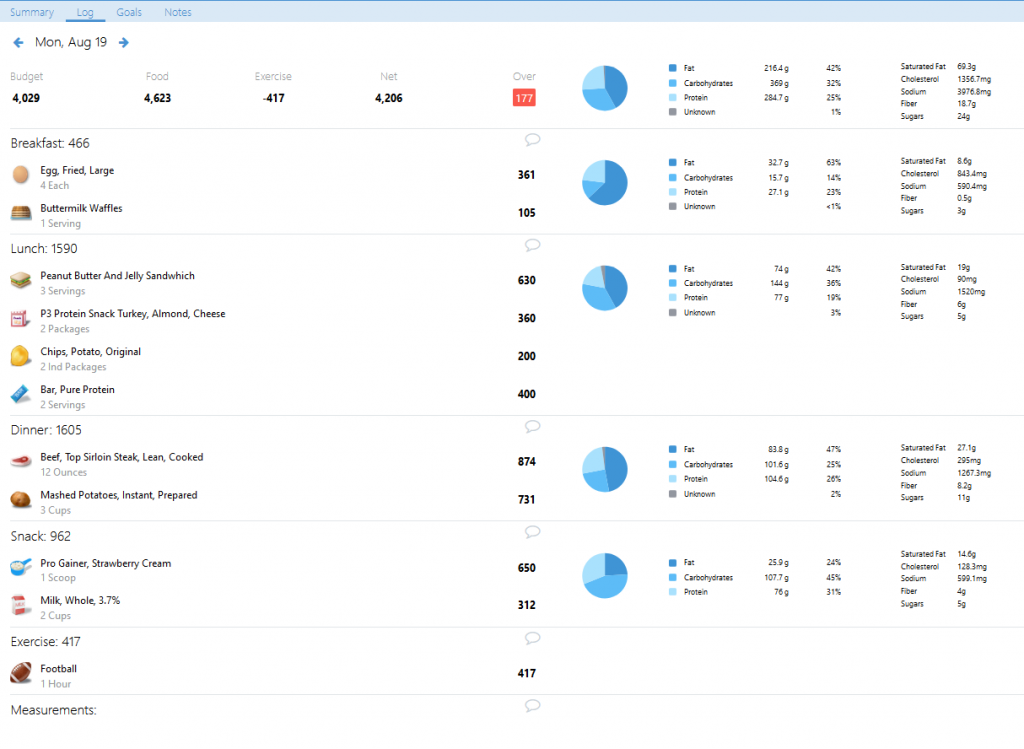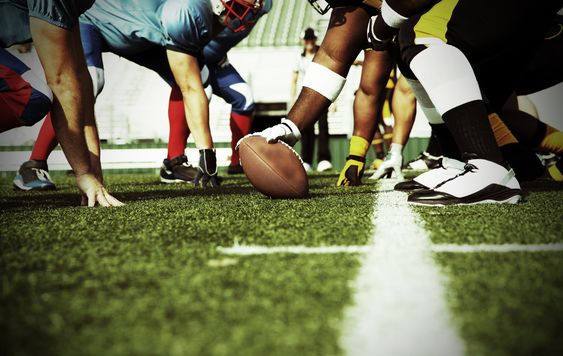How To Eat During High School Football Season
Your goal is to out-eat and out-sleep your competition.
Your alarm goes off. It’s a school day. Ugh.
You’ve got to get up, take a shower, get dressed, eat, get your schoolwork, get your lunch, get your backpack and get out the door. You’ve got morning high school football practice, followed by several classes and then a football game this evening. At this point, you don’t really care about food other than you know you’re hungry. When you’re hungry all of the nutrition talk goes out the window. You just want to feed the beast with whatever’s handy. It doesn’t really matter what you eat, as long as you eat.
When I was in high school, I did it too. And sometimes, I went the other direction and didn’t eat anything for breakfast.
Big mistake.
Costly, Catabolic Blunder
Repeat this mindless eating plan day after day and you’ll get weaker, lose size and get run over by your bigger, stronger football opponents. NFL, College, and now High School football players are bigger, faster and stronger than ever. You can’t afford to go catabolic. Not when it’s easy to avoid.
Cortisol is a catabolic hormone. If we place the body under increased stress for long periods, through poor lifestyle choices, lack of sleep, poor eating, over-training, under-recovery and severe long-term energy deficits we get chronic elevations in cortisol, and this is where catabolism can turn nasty and start eating into muscle tissue. For football players muscle is armor. As long as you can move in that armor, the more armor the better. Armor will protect you.
I’m in the process of completing Summer Progress Reports for my athletes. As I share Summer strength, speed, performance gains with parents, I have been touching upon the importance of continuing to strength train throughout the season, using good nutrition habits, and making time for recovery, and rehab. Following this advice can help a high school football player stay injury resistant and play at a very high level all season long.
There are typically 4 things that happen to a football player during the football season:
(in order of least favorable to most favorable)
1) They get injured. Whether we like it or not, it happens. Extra muscle and size is armor. The more armor the more injury resistant.
2) They LOSE size, strength, and power during the season. This is what happens to most players. They are weakest at the end of the season when they need to be their strongest.
3) They MAINTAIN size, strength, and power during the season. This is ideal but will only happen if they pay attention to nutrition and follow an intelligent, consistent, intense workout routine.
4) They GAIN size, strength, and power during the season. This is the Holy Grail and will happen to 1-3% of the football players out there.
This is our goal at Scott York Fitness.
Your training is truly one of the best decisions we’ve ever made. We love everything about you and the program. He is very confident and knows he has lots of room to grow and get stronger. M.L. / Cedar Park, Texas
Nutrition Is The Key
One of the biggest holes in your game is your nutrition. You know it, I know it and when you’re on the field it will rear its ugly head. If you find yourself on your back looking up at the stadium lights wondering what happened, it’s possible that you just got run over. And while this is usually one of the biggest holes in a football players preparation, it can easily be fixed.
Take a look at the screenshot below.

If you’re an active teenager who is burning a lot of calories with high school football, here is a good example of how you might consider eating. This is one of my athletes who has gained 34 pounds in 15 months – through illness, vacations and unforeseen circumstances. He’s been consistent and is reaping the rewards as a result. He’s bigger, faster and stronger and he just started his sophomore year. His calories are ample up to this point (I monitor his weight weekly), his protein is high and his food choices for a high school teenager are good. Of course, we always want our kids to eat more fruit and veggies but, you know, they are teenagers.
Top Takeaways
- If you don’t eat enough, you will get smaller and weaker. These high school athletes are undergoing or are about to undergo a huge growth spurt AND they are burning a ton of calories each day in athletics.
- You have to have an intelligent starting point. If you are not a numbers nerd like me, a decent starting point would be 3500 calories a day. Of course, body type plays a role. If your athlete is overweight, they may need to lose some body fat on a slightly lower-calorie diet, if they are doing things correctly (eating, lifting, sleeping) this will then change their body composition and their metabolism from a sugar burner to a fat burner. At that point, raise their calories as they begin to build more muscle. If your athlete is tall and thin, they may need more calories to start out but you have to be careful not to overload them in the beginning. Start at 3500 calories a day and then add 300-500 if they are not gaining weight until you get to 4300-4500 a day. At some point, they WILL start gaining weight. It could be 4500, 5000, 5500 calories a day but at some point, they will gain weight consistently.
- Undereating is the norm. I have been logging my food since local cattlemen began using fence posts to keep their cows fenced in. Actually since Thursday, Jan 14, 2010. In the past 3 years, I have logged the daily nutrition of over 100 different athletes (high school)—every day except holidays like Christmas and the occasional off day. I have looked at thousands and thousands of days of entries by my athletes. Without fail, 99% of them do not eat enough. And without fail, once they learn to eat correctly and log their food, they get bigger, faster, and stronger.
- Put protein powder on the grocery list. Understand that protein powder or a weight gain powder are not supplements they are food. They go on the grocery list. I currently recommend BSN Syntha 6 for athletes who have gained enough weight and Optimum Nutrition Pro Gainer for those who need to gain weight.
- Spring of 8th grade seems to be the time to get serious. I’ve trained younger and older athletes. The younger athletes may still be emotionally and physically immature for my Strength and Performance program although I had good success with my Foundation Program that I started this Summer with local athletes who are going into the 8th grade. The 9th and 10th graders are going to be behind if they wait until then (9th/10th grade) to start a nutritional overhaul and a serious strength program. My athletes are typically 6 months to a year ahead of other athletes in terms of strength, power, speed, and size. Sometimes more than 6-12 months. That’s huge in high school sports where you only get 4 years. I hear it all the time from my older athletes – “I wish I had started your program sooner.”
Another Example

This example comes from another one of my high school football players. In this example, he was over on his calories for this day (good), his protein was high (good), his sugar was 134 grams (125 grams or less is his daily goal), he ate multiple meals and snacks (4-6), and he gave himself a constant supply of protein throughout the day (good).
Now. If he had burned 800 calories from football and weight lifting, he would need to eat more in order to avoid undereating. This is what trips up most high school athletes. They don’t account for the calories that they burn through exercise. If you don’t dig into the numbers then you are just guessing. Guessing won’t work.
- I guess you’ll start
- I guess you’ll get stronger
- I guess you’ll eat enough
- I guess you’ll have a winning season

In order to get results, you have to educate the athletes, have them log their food each day, monitor their food each day, and adjust whatever may need adjusting – protein, calories, meal frequency, quality of food, etc. Leave nothing to chance. That’s how it’s done. Too much work? OK. Then you just didn’t want it bad enough.
Trends
Finally, one of the top trends that I see is 8th, 9th, and 10th-grade football teams finding out that all of a sudden when they get into their high school varsity season, winning becomes a little harder. They went 8-2 their freshman year, undefeated their JV year but then struggle to win 5 games their senior year. What happened? The other high school players got bigger, faster, and stronger and the varsity coaching got a little better. You got left behind. A lot of these kids don’t hit their growth spurt until 10th – 11th grade. While you stayed the same, you got passed up by other football players who took their nutrition, rest, and recovery more seriously.
Nutrition is overlooked but solid nutrition has the power to enhance so many different systems in the body and not just from a health perspective, it can have massive contributions towards your performance where it matters, out on the playing field. In a sport such as football where everything is measured in inches and seconds, getting every advantage you possibly can is a must.
To sum up, pay attention to nutrition. Each day matters. Establish an intelligent daily calorie goal that is specific to you. Log your meals using one of the many free nutrition software programs. Eat enough protein. Weigh yourself at least once a week. Adjust your calories, protein, carbs, etc as needed. You’ll be amazed at the results. Your performance will improve, your clarity of thinking will improve (focus) and your recovery will improve.

